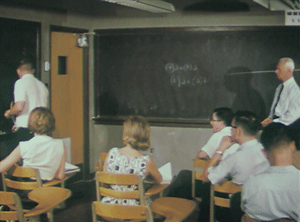Robert Lee Moore (1882-1974) was a towering figure in twentieth century mathematics, internationally recognized as founder of his own school of topology, which produced some of the most significant mathematicians in that field. The 50 students he guided to their PhDs can today claim 1,678 doctoral descendants. Many of them are still teaching courses in the style of their mentor, known universally as the Moore Method, which he devised. Its principal edicts virtually prohibit students from using textbooks during the learning process, call for only the briefest of lectures in class and demand no collaboration or conferring between classmates. (Exceptions were Moore's calculus and analytic geometry courses in which textbooks were used for setting problems. His doctoral students were allowed to refer to the literature mainly to ensure their theses were original.) It is in essence a Socratic method that encourages students to solve problems using their own skills of critical analysis and creativity. Moore summed it up in just eleven words: 'That student is taught the best who is told the least.'
-- From J. Parker, R. L. Moore: Mathematician and Teacher (Mathematical Association of America, 2005), p. vii.
Moore's long life was mainly devoted to mathematics and to his students but it intersected with many of the principal social issues of 20th-century America. Some of the key events are given in A Chronology of Moore's Life and Times. See also Wikipedia.

(From the film produced by the Mathematical Association of America.)
His success has inspired others to develop variations.
Introductions:I do not consider it important in using the Moore method whether one lectures a lot, a little or none at all. It is important that there be regular interaction with the students so that the instructor knows how well the students understand the material. It is also important that they be given challenging problems, be motivated to work on them and to want to report their progress. ... One should expect progress to be very slow at first, but to improve as the students develop. And to slow down again with new concepts. This requires a lot of patience. ... One should not consider material covered until the students understand it well enough to apply it in new situations.
I also think the term Discovery Learning is misleading. The student is not likely at an early stage to discover enough on his own to satisfy us in our attempts to cover the syllabus. A better term might be cooperative learning with the instructor taking the lead. In the beginning I give some definitions and ask questions which result in a discussion in class about the meaning of the definitions.
-- William S. Mahavier (Moore PhD 1957), quoted from "What is the Moore Method?"
Courses with broader audiences present different challenges to using the Moore method. Beginning courses are often stocked with students whose only interest appears to be to get a required mathematics credit and whose primary commitment seems to be to pull a passing grade with as little work as possible. Service courses are often dictated by syllabi that seem to be largely geared to putting a technique in a student's hand in time for application in the course being served. Nevertheless, the principles that guide the structure of Moore-method courses are still applicable. I have found that trying to do something about what I perceive to be flaws in the textbooks or the tyranny of the syllabus can bring Moore-style principles into play.
-- G.Edgar Parker (John Neuberger PhD 1977), quoted from "Getting More from Moore."
The small group discovery method was developed in 1967 at the University of Wisconsin by Neil Davidson. He started with the idea established by R.L. Moore that bright students can develop mathematics. He then changed the social environment so as to render the idea workable for much larger numbers of students in undergraduate courses.
-- J. Dancis (RH Bing PhD 1966) & N. Davidson (J. Harvey PhD 1970),
quoted from "The Texas Method and the Small Group Discovery Method."
The Moore Method in 60 Minutes: A Demonstration by Robert Kauffman
The Moore Method in 60 Minutes: A Demonstration by Ted Mahavier
A Quick-Start Guide to the Moore Method (160 KB PDF file)
The R.L. Moore Legacy Project
Comments to the Legacy Webmaster

